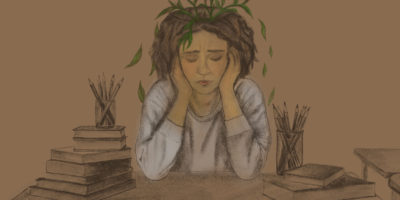By Budimir Markovic
BELGRADE, SERBIA – From the onset of the protests, students tried to distance themselves from the communist regime and the opposition coalition. We wanted to keep the protests non-partisan. Out slogan was “Neither Left, nor Right, but Forward!” (this is a pun, as the Serbian word for “forward” also means “law” and in this context “rule of law”). We believed this was the only way for the protests to have the power needed to realize our demands. We demanded: The recognition of the municipal election results; the resignation of the university rector and the resignation of his student deputy.
The first days of the protest were spent organizing. The deans and professors were afraid to support us so starting out was very difficult. University authorities threatened the leaders of the protest but the protest had begun and nothing could stop it. Unlike the previous protest in 1991 we decided to leave the university and take our protest to the streets. Instead of holding rallies, we chose to march.
Each march began in front of the school of philosophy where students were addressed by prominent professors, actors, musicians and public personalities, who expressed full support for our demands. Then we marched through the streets of Belgrade. Each march would go a different route but we always ended up where we began. We chose a “weapon” which became the hallmark of the protest — the whistle. One of the basic ideas of the protest was to attract the attention of our fellow citizens. We wanted them to see the situation Serbia was in and encourage them to act. The students of Belgrade, joined by our counterparts from other university towns in Serbia, created a noise which echoed through the streets of Belgrade to encourage our fellow citizens to join us.
During the protest, we formed agencies: security, logistics, propaganda, press, internet and many others. Everybody did what they were best suited to. We also formed a small assembly and a student government and each faculty had its own headquarters. The main headquarters from the protest was located at the school of philosophy, whose administration took the students’ side from the very start and persevered in aiding the protest. The dean of the school of philosophy was Marija Bogdanovic, whom we wanted to take over the rectorship of Belgrade University following the dismissal of the previous one in accordance with our demands.
The student marches and separate marches by supporters of the opposition continued for two months. Each protest amassed more and more people as it went. Similar marches took place in many towns throughout Serbia. In response to the growing protests the communist regime chose an irrational course of action that could have been disastrous. The regime organized a counter protest rally at the same location where the students usually gathered. They bussed in government supporter from the rest of Serbia and gathered the few Belgraders who supported them. That day was trying for us protesters. The student procession came into contact with sympathizers of the communist regime on several occasions and small skirmishes broke out. Several of the opposing side’s signs were confiscated but, luckily, large-scale conflict was avoided. Unfortunately, opposition supporters and communist backers also clashed, leaving one person dead and another paralyzed for life after being shot in the head.
After the clash, police took up an active presence on the streets of Belgrade and other cities in Serbia. They appeared with cordons to prevent marches by the students and opposition supporters. At first, we reacted by diverting our march to smaller streets but we were again met with our hands on our heads, in a symbolic gesture to show we were in a form of prison. In order to block all streets, the regime needed many policemen. But, we finally came up with a plan to overcome the blockade. As the schools of Belgrade University are located throughout the city (not in a single campus) we resolved to start our march from five starting points and meet downtown. In this way, the police did not know how to react and we once again marched through the city unobstructed. This was our first victory.
For some time afterwards, the cordons were removed and we were once again able to march in our previous manner. At that time, the opposition parties chose a similar marching model, with several starting points and a rendezvous downtown. However, when one of the processions was locked, police brutally intervened with batons, injuring more than 40 people. In an attempt to avoid the police, a group of protesters sought refuge in the school of philosophy, but police followed. Several members of the student security service were hurt and the glass of the doors of the faculty were smashed. The same occured on two other occasions. We subsequently added the punishment of the persons responsible for that violation of the law to our list of demands. During the brutal police raids, a number of students were injured and one student reporting for a student newspaper had to be hospitalized.
After that, we decided we would never again retreat from a police cordon. Twice, the cordon pulled back after 10 hours and we marched through the streets of Belgrade scoring two more decisive victories over the regime and its police. The third time, the cordon refused to retreat for seven days. For a full seven, cold January days, students stood before the cordon in a contest of nerves. The seventh day was St. Sava’s Day (St. Sava is the greatest and first Serb educator and saint), and the Serb Orthodox Church organized a procession through the streets of Belgrade and forced the cordon to retreat. During the standoff between police and students, we were backed by a large number of prominent people from Serbia and the rest of the world. The most important backing came from Serb Patriarch Pavle, who gave the students more support than anybody ever had.
The marches continued. Meanwhile, international pressure forced the communist regime to recognize the election results. Opposition supporters left the streets, as their demands had been fulfilled. But we remained true to our interests and continued to protest for another month and a half until the rector and his deputy resigned. In the meantime, students from Nis, Kragujevac and Novi Sad came to Belgrade on foot in order to extend their support. In winter, such an endeavor is really a heroic act. No kind of pressure could cause the students to falter; after 120 days, the regime was compelled to meet our demands. Everything ended with a majestic victory march and the formation of the student parliament as an institutionalized continuation of the student protest.
The students of Serbia could have never taken this great step towards democratization without decisive support from the citizens of Serbia and Belgrade as well as support from the rest of the world. Every day we received a large number of letters, telegrams and emails calling on us to persevere and continue to fight for what is right. Unfortunately, this protest was only a small step forward. Now, the students of Serbia have much greater problems than before.
At present, the authorities are dealing with is in ways much worse than police cordons. However, I still hope that one day I will live in a free and democratic Serbia and Belgrade.










Leave a Reply